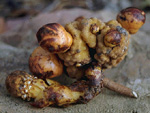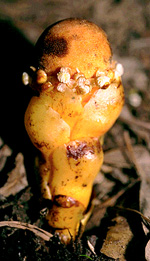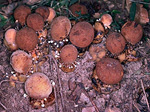 |
This is a small, pantropical family, represented in Australia by a single species of the bizarre, parasitic genus Balanophora (B. fungosa) found amongst leaf litter beneath rain forest in eastern Queensland, most commonly in the north of the State.
Characteristic features of the family Balanophoraceae in Australia include: - highly modified, leafless, achlorophyllous, tuberous parasites on the roots of rain forest trees
- flowers densely clustered on fungus-like, bract-covered outgrowths from an underground tuber, with separate male flowers and female flowers on each inflorescence (males around the base of a club-shaped apex comprising tightly-packed female flowers)
- male fowers with a 3-8-lobed perianth and many stamens in a globular mass, the anthers splitting transversely; female flowers without a perianth
Description
Terrestrial parasitic or semiparasitic herbs perennating by tubers. Vegetative reproduction by tubers. Leaves ±absent and the stems succulent or plants apparently lacking recognisable stems or leaves. Chlorophyll absent and the whole plant whitish, yellowish or brownish. Plants partially or totally parasitic on the roots of the host. Internal secretions not obvious. Plants glabrous. Leaves well developed or much reduced (i.e. to scales, etc.), alternate and spiral, cauline, sessile. Stipules absent. Lamina simple, symmetric; lanceolate, ovate, oblanceolate or obovate; base cuneate; margins entire, involute or incurved; one-veined, with the midrib inconspicuous, and the tertiary venation not reticulate; surfaces not punctate; succulent. Male and female flowers occurring on the same plant or on separate plants. Inflorescences terminal, consisting of capitula, spikes or racemes. Bracts present. Bracteoles present or absent. Flowers sessile or stalked. Floral disc absent. Perianth regular, of 1 whorl only or absent, with 3–6 (–14) free petaloid segments, yellow, red, magenta, purple, violet, grey, brown or black, without contrasting markings, succulent. Fertile stamens 3–6 (–10), opposite to and free of the perianth segments, free of the ovary and style, fused by their anthers, all ±equal. Staminal filaments absent. Anthers not versatile, opening sideways by transverse slits; 4-celled. Ovary superior and sessile. Carpel 1; ovary with 1 locule. Style terminal, single and unbranched and the stigma clavate. Ovule 1, sessile; placentation apical. Fruit dry, indehiscent, nut-like; the perianth on the maturing fruit deciduous. Disseminule micro-surface ±smooth. Seeds 1 per fruit. Aril absent. Cotyledons 0. Embryo round or shapeless.
(Note: this description has been generated from the coded data compiled for the key. Any errors in the key data will be reflected in the descriptions.)
A treatment of the family Balanophoraceae has been published in:
Flora of Australia 22: 146-147.
Australian genera of Balanophoraceae (as recognised for the Flora of Australia)
Balanophora

|
  |

Balanophora fungosa (excavated plant showing tuber)
Photo: C.Green © ANBG

Balanophora fungosa (flowering plant)
Photo: D.Jones © D.Jones

Balanophora fungosa (flowering plants)
Photo: H.Nicholson © H. & N. Nicholson

Balanophora fungosa (flowering plants)
Photo: M.Fagg © M.Fagg
|
 |
|